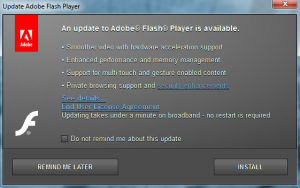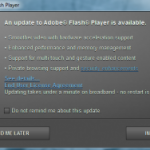Summary:
- This vulnerability affects: Adobe Flash Player 11.1.102.55 and earlier, running on all platforms. This also affects the Android version of Flash.
- How an attacker exploits it: By enticing your users to visit a website containing malicious Flash content
- Impact: In the worst case, an attacker can execute code on your computer, potentially gaining control of it
- What to do: Download and install the latest version of Adobe Flash Player
Exposure:
Adobe Flash Player displays interactive, animated web content called Flash. Though Flash is optional, 99% of PC users download and install it to view multimedia web content. It runs on many operating systems, including some mobiles like Android.
 In a security bulletin released yesterday, Adobe warned of seven vulnerabilities (based on CVE numbers) that affect Adobe Flash Player 11.1.102.55 and earlier running on all platforms (including Android). Adobe’s bulletin doesn’t describe the flaws in much detail. However, it does warn that if an attacker can entice one of your users to visit a malicious website containing specially crafted Flash content, he could exploit many of these unspecified vulnerabilities to execute code on that user’s computer, with that user’s privileges. If your Windows users have local administrator privileges, an attacker could exploit this flaw to gain full control of their PCs.
In a security bulletin released yesterday, Adobe warned of seven vulnerabilities (based on CVE numbers) that affect Adobe Flash Player 11.1.102.55 and earlier running on all platforms (including Android). Adobe’s bulletin doesn’t describe the flaws in much detail. However, it does warn that if an attacker can entice one of your users to visit a malicious website containing specially crafted Flash content, he could exploit many of these unspecified vulnerabilities to execute code on that user’s computer, with that user’s privileges. If your Windows users have local administrator privileges, an attacker could exploit this flaw to gain full control of their PCs.
Adobe also warns that attackers are exploiting one of these flaws, a zero day XSS vulnerability, in the wild. If you use Adobe Flash Player in your network, we recommend you download and deploy the latest version throughout your network immediately to mitigate the risk of this current attack.
Solution Path
Adobe has released new versions of Flash Player (11.1.102.62 for computers and 11.1.11x.x for Androids) to fix these issues. If you allow Adobe Flash in your network, you should download and install the new versions immediately:
- Download Flash Player for your computer [any platform]:
- Download Flash f0r Android 4.x [Visit from your Android device]
- Download Flash Player for Android 3.x and below [Visit from your Android device]
For All WatchGuard Users:
If you choose, you can configure the HTTP proxy on your XTM appliance to block Flash content. Keep in mind, doing so blocks all Flash content, whether legitimate or malicious.
Our proxies offer many ways for you to block files and content, including by file extension, MIME type, or by using very specific hexidecimal patterns found in the body of a message – a technique sometimes referred to as Magic Byte detection. Below I list the various ways you can identify various Flash files:
File Extension:
- .flv – Adobe Flash file (file typically used on websites)
- .fla – Flash movie file
- .f4v – Flash video file
- .f4p – Protected Flash video file
- .f4a – Flash audio file
- .f4b – Flash audiobook file
MIME types:
- video/x-flv
- video/mp4 (used for more than just Flash)
- audio/mp4 (used for more than just Flash)
FILExt.com reported Magic Byte Pattern:
- Hex FLV: 46 4C 56 01
- ASCII FLV: FLV
- Hex FLA: D0 CF 11 E0 A1 B1 1A E1 00
(Keep in mind, not all the Hex and ASCII patterns shared here are appropriate for content blocking. If the pattern is too short, or not unique enough, blocking with them could result in many false positives)
If you decide you want to block Flash files, the links below contain instructions that will help you configure your Firebox proxy’s content blocking features using the file and MIME information listed above.
- XTM Appliance with WSM 11.x
- Firebox X Edge running 10.x
- Firebox X Core and X Peak running Fireware 10.x
Status:
Adobe has released updates to fix these Flash vulnerabilities.
References:
This alert was researched and written by Corey Nachreiner, CISSP.
You Can Learn More About the WatchGuards’ Product Line By Going to www.FirewallShop.com/WatchGuard.
The original article/video can be found at Adobe Flash Update Plugs Zero Day XSS Hole and Others



